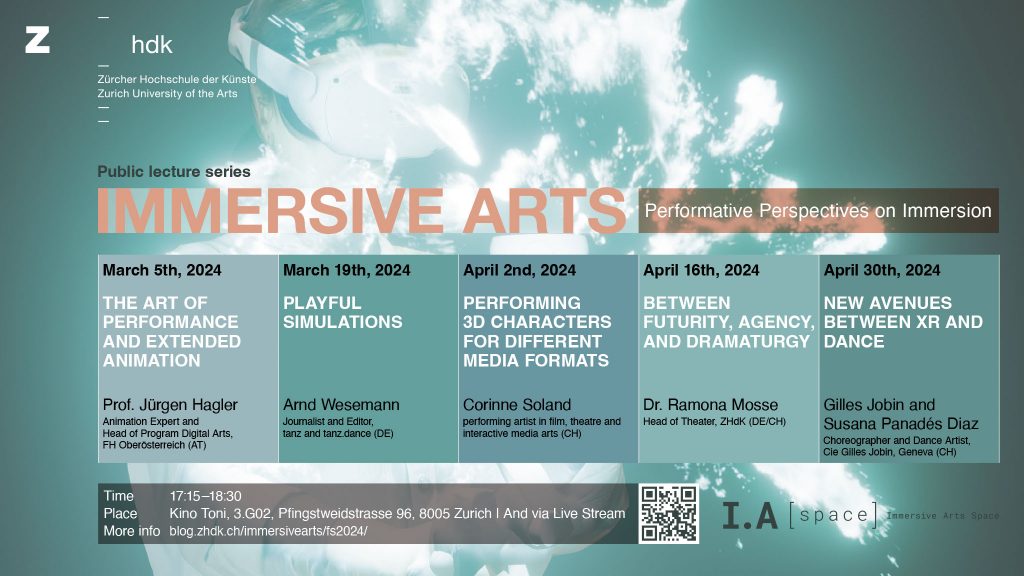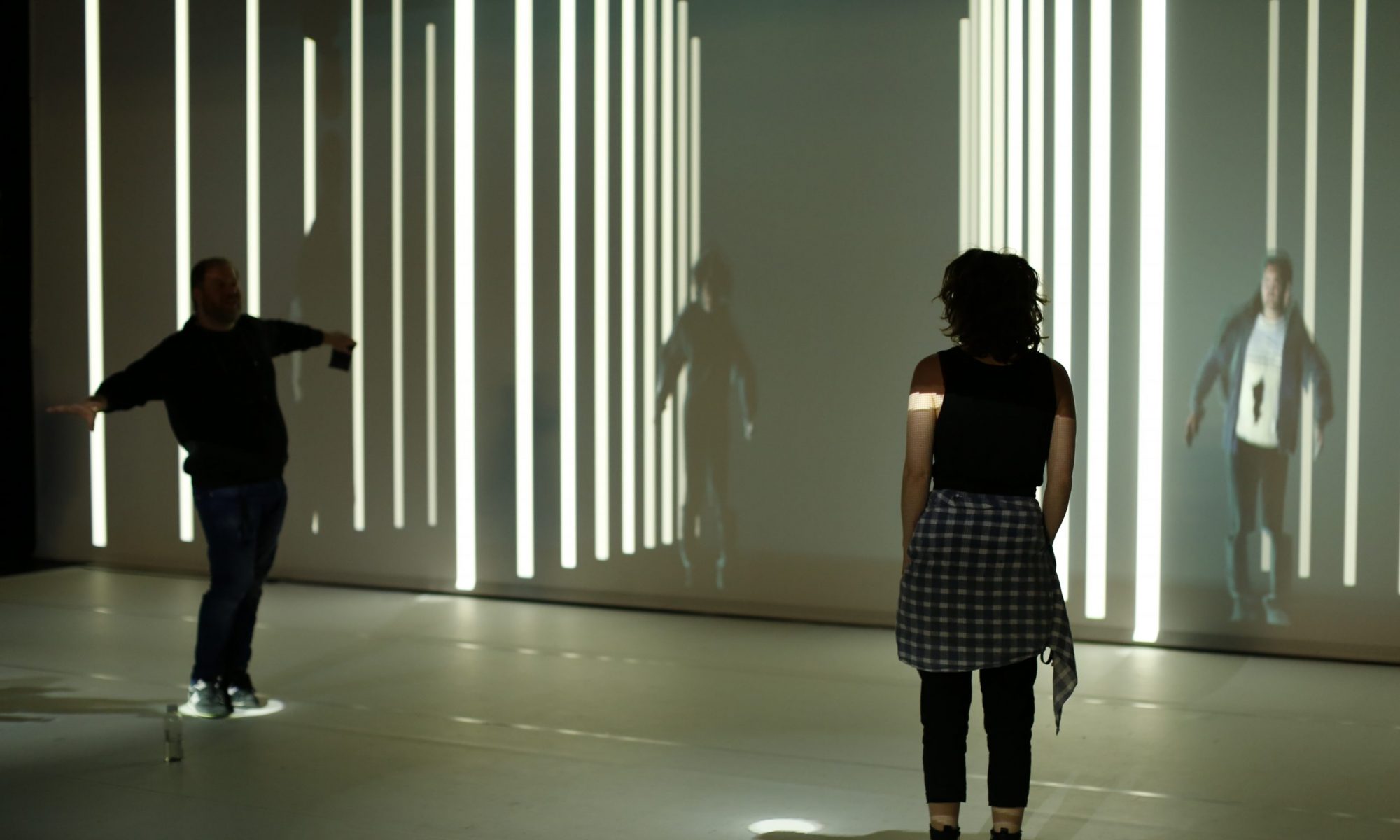Immersive Arts: Performative Perspectives on Immersion

The immersive arts lecture series for Spring Semester 2024 investigates questions of immersion from the perspectives of the performing arts including dance, theater and even real time animation. Our exciting list of five guest lecturers includes Prof. Juergen Hagler (the head of the Ars Electronica animation jury), Arnd Wesemann (journalist and long-time editor of tanz), Corinne Soland (performing artist in film, theatre and interactive media arts), Dr. Ramona Mosse (head of the theater program at the ZHdK) as well as Gilles Jobin and Susana Panadés Diaz (world renowned choreographer and collaborating dance artist working with real time motion capture).
The pubic lecture series take place at the Kino Toni (room 3.G02, Pfingstweidstrasse 96) from 17:15-18:30h. They will be also available via live stream.
THE ART OF PERFORMANCE AND EXTENDED ANIMATION
Prof. Jürgen Hagler | March 5th, 2024
Performance is a word that evokes a multitude of interpretations. In the simplest terms, performance describes the act of executing a task or function, but it also encompasses the staging and presentation of the act itself. As a form of artistic expression, such an act can be a play, a piece of music, a dance choreography, or in the case of this lecture, live animation. In contrast to animated films, performative acts are typically unique, and though they can be repeated, each differs in some way. Immediacy and unpredictability, among many other qualities, are the building blocks of performance in this context. But all animations, whether pre-recorded or live, are essentially a composition of static elements brought to life as a performative act.
Jürgen Hagler (AT) studied art education, experimental visual design, and cultural studies at the University for Art and Design in Linz, Austria. He currently works as a professor of Computer Animation and Animation Studies in the Digital Media department at the Hagenberg Campus of the University of Applied Sciences Upper Austria. Since 2014 he a leading researcher of the research group Playful Interactive Environments with a focus on the investigation of new and natural playful forms of interaction and the use of playful mechanisms to encourage specific behavioral patterns. Since 2009 he is the curator of the Ars Electronica Animation Festival and initiator and organizer of the symposium Expanded Animation
PLAYFUL SIMULATIONS
Arnd Wesemann | March 19th, 2024
It’s funny: All theatres, next to their museum function, assert a claim to political realism. For example, a theatre that only would like to see poverty represented on the stage by the poor would therefore be a Poor Theatre. Likewise, a theatre that would only allows digital artificiality would therefore be called an Artificial Theatre. Are either of these true? Can a theatre become a place where even non-human sensors, data and artificial intelligence play a role? Or isn’t the theatre the place where precisely everything plays a role, in this case, even technologies. In this sense, Theatre would therefore be the place where we would no longer blindly trust the calculations of models or the actions of autonomous software. This talk proposes therefore the question: Don’t we owe technology one thing above all else: a playful approach to it? Raise the curtain on a theatre of true virtuality which will allow us to experience all kinds of possibilities.
Arnd Wesemann (DE) is long-time editor of the German magazine tanz. He studied Applied Theatre Studies, a then newly formed professional education program of the University of Giessen, graduating in 1987. In 1990 he became a free-lance writer on advanced theatre and arts phenomena, publishing essays and reports on contemporary theatre, dance and New Media events in magazines such as tanz, Theater der Zeit and the Swiss-printed magazine Musik & Theater. He has been a regular contributor to the Süddeutsche Zeitung, reporting about new tendencies in European theatres. In the field of electronic media, dance and the respecting performing arts, he freelanced for Die Zeit, Frankfurter Rundschau and Screen Multimedia. In October 1994 he published a monograph on the Flemish avant garde stage director Jan Fabre with Fischer-Verlag and the book Data dummies & Net nomades with Fannei & Walz, Berlin. Since 1997 he is editing Europe’s Leading Dance Magazine, tanz, now in his 25th year and now the Global dance platform tanz.dance. He has been lecturing, teaching on Dance und New Media as well as serving on numerous juries and panels.
PERFORMING 3D CHARACTERS FOR DIFFERENT MEDIA FORMATS
Corinne Soland | April 2nd, 2024
In the world of performing arts, actors and performers are not exclusively in demand for theater, film or circus. Characters are also brought to life in video games, interactive installations and virtual reality films. Corinne Soland leads us through movement exercises to understand the process of training locomotion for “the Volume” – the capture stage. What are differences in Game movement versus Narrative 360° Stories? The Immersive Arts Space researcher gives insights on how to teach performance with MoCap technologies and if (& how) this technology can shape and shift a performance. With a focus on acting, the lecture provides key concepts and current topics of Corinnes research at the IASpace in chosen past and current projects as well as accumulated knowledge of production at the intersection with performers’ needs in the Volume.
Corinne Soland (CH) is a performing artist in film, theatre and interactive media arts. After completing a Motion Capture training with Performance Captured Academy (PCA UK) in 2019, Corinne has recorded movement for both 2D and 3D programs. Selected projects include Kusunda VR (NowHere Media, GER/INDIA), The Conspiracy (Third Party Film, USA), Amazing Monster! (wowl!, SmallCreative CH/FR) and LimitsVR (Tell Me the Story Prod. CH/FR). A freelance actor and voice over talent for both animation as well as live-action projects, Corinne’s latest roles are Dimitri in the TV Series “Guetnachtgschichtli” (SRF) and Anna in Neumatt (SRF, Zodiac, Netflix). Since 2019 Corinne is part of the Immersive Arts Space team as a research associate. Corinne teaches students coming from different disciplines how to translate their movement into a characters’ body narrative through the MoCap technology in Workshops and ZHdK seminars.
THE NETWORKED STAGE: BETWEEN FUTURITY, AGENCY, AND DRAMATURGY
Prof. Dr. Chris Salter | April 16th, 2024
Theatres of the future are frequently invoked in the German-speaking cultural landscape to mark a crisis of institutions and to question theatre’s mandate in a publicly funded system. Yet, in this talk, Ramona Mosse would like to coin the futurity of theatre along a different trajectory and map the digital dramaturgies of the networked stage, i.e. a radically expanded theatre in which digital technologies have reshaped the space of performance and in which our established concepts of agency and authorship no longer hold. What is at stake, then, in such a hybrid future of theatre that had been so frequently called upon during the COVID pandemic? How does the reality differ from the manifestoes for a digital theatre future, spurred on by the 772% increase in digital theatre ticket sales (ETC Digital Theatre Study) during the pandemic? To explore these questions, Mosse will use the founding of and artistic programming at the HAU4, the digital stage of the HAU Hebbel-am-Ufer Theater in Berlin, as a case study. In particular, its resident artist group Interrobang moves into focus with their recent work “Commune AI” (2023), in which a digital audience sets out to build a virtual community, moderated by an AI.
Ramona Mosse (DE/CH) is the Head of Theatre at the Zurich University of the Arts. She has taught at the Free University Berlin, the Goethe University Frankfurt, Bard College Berlin, and Columbia University. In her research, she explores digitality in performance, genre and media in/of the theatre, and contemporary political performance practices. From 2021-2022, she headed up the VolkswagenFoundation funded research project Viral Theatres, which documents the aesthetic shifts of pandemic theatre-making.
COSMOGONY: NEW AVENUES BETWEEN XR AND DANCE
Gilles Jobin and Susana Panadés Diaz | April 30th, 2024
Cie Gilles Jobin is focusing on technology and innovation for real time performances at a distance. Creating multiple groundbreaking projects Gilles Jobin is recognized as one of a leading creative force in the XR world. Gilles is regularly invited as an international guest lecturer on dance and technology in Europe, Asia and Americas. Geneva’s company studio is equipped for motion capture and digital creation and structured as an affordable research and production center for motion capture and digital technology from the point of view of the performing arts. In this talk, Jobin and his main dancer/collaborator Susana Panadés Diaz will discuss the company’s artistic process working with technologies like Motion Capture and Virtual Reality.
Gilles Jobin (CH) is a choreographer living and working in Geneva whose productions have been performed all over the world since 1995. Based in London from 1997 to 2004 he created the groundbreaking pieces A+B=X (1997), Braindance (1999), The Moebius Strip (2001) and Under Construction (2002), relying on choreographic language outside of established aesthetic frameworks that included forays into visual arts and live art. In 2003 he created TWO-THOUSAND-AND-THREE for the 22 dancers of the Ballet of the Grand Théâtre de Genève for a performance that “transcends both classical and contemporary dance” (Libération). His creations are being presented in major film festivals such as the Sundance Film Festival (2018 and 2020) and the Venice Film Biennial (2018 and 2020), leading dance festivals such as the Lyon Dance Biennial (2018) or BAM (2019) in New York or museums such as Haus For Electronishe Kunst / HEK in Basel. With the same creative team and dancers behind Magic Window (2019) and Dance Trail (2020), two augmented reality dance pieces, followed by La Comédie Virtuelle a multiuser VR piece and La Comédie Virtuelle – live show a real time multiuser performance in VR. In 2021 he created Cosmogony, a dance piece motion captured live in the company’s studios and streamed in real time globally.
Susana Panadés Diaz (CH) studied classical and contemporary dance at the Institut del Teatre in Barcelona, before entering the P.A.R.T.S.programme in Brussels, directed by Anne Teresa de Keersmaeker. She worked with Caterina Sagna’s dance company in 2001 on the creation of Sorelline. From 1999 to 2004 she worked as a performer with Fabienne Berger in: Azur Blues, Natal, Océane Lili and Avril en mai. Since 2005 she has worked with Cie Gilles Jobin as a performer in a variety of projects. She was part of the cast for The Moebius Strip (Pachuca 2007) and A+B=X (Paris 2010) re-runs and has also worked as artistic assistant and multimedia manager for the company. Susana Panades Diaz is Cie Gilles Jobin’s main dance artist. She is an expert in digital motion capture. Member of the Cie Gilles Jobin since 2005, Susana is extremely familiar with the company’s dance style. Her role is to resolve issues related to the optimisation of motion capture from the point of view of the performers.

